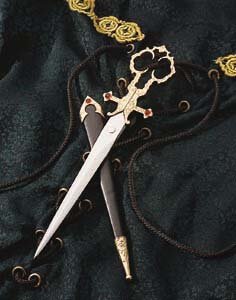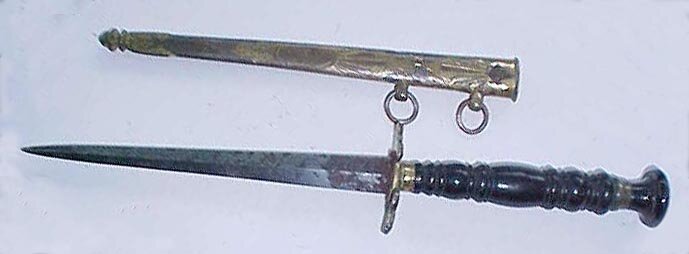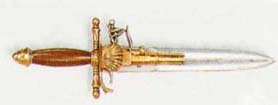
A dagger is anyone of many kinds of fighting knifes (dirks, main gauche, stiletto, poignard, etc). Daggers were designed to be thrusted at an opponent. They were not very effective when it came to slashing, although typically both sides of the blade have an edge. Unlike the Gully, daggers have hilts or cross bars which prevent the hand from slipping forward on to the blade and helps to protect the hand in the event of another blade sliding down the dagger's blade.
Daggers were an instrumental part of fencing in that they were used to parry an attack and keep one's opponent off guard. Many daggers were specially designed to break an opponents blade. These were called parrying daggers or blade breakers.
Rarely would two men lock blades together with their faces inches apart as depicted in the movies. If one were to get that close, a dagger would most certainly have come into play.
Examples of daggers are listed below.
A rapier with matching parrying dagger

Note how the hilt forms two almost enclosed circles. The enclosures are designed to allow an opponents sword to slide down the dagger's blade and be caught within the circles. If such an event occurs, it makes it possible for the dagger's owner to snap or at least capture the opponent's sword blade with a turn of the wrist. Such enclosures are known simply enough as "Blade Breakers"
A Poinard
(Also: Poignard and sometimes Ponyard in Middle English)

The poinard is a stabbing knife often worn by the upper class or noblemen. Note its similarity to a parrying dagger. The main difference is the poinard wasn't necessaily designed to be used when fencing.
Bodice Dagger

Many daggers were designed for concealment, such was the bodice dagger. The item to the left would normally be worn in the cleavage of a woman, running down the front of her corset. In the event that she would find herself in peril she could easily pull the dagger out and surprise her attacker.
This particular example also doubles as a pair of scissors!
Naval Dirk

Naval Dirk were often given to midshipman or junior officers. Originally they were functional fighting daggers but today they tend to be more ceremonial. This particular dirk is of Irish origin and has a Masonic crest on the scabbard, and was most likely a gift to junior naval officer. Today, dirks are still often presented to junior officers and their basic design has changed little in the last 500 years.
Dagger pistol

Another oddity from the 16th-17th Century, is the Dagger Pistol. The idea was to still have a suitable weapon for close-quarter fighting after you pulled the trigger and missed. A better idea is pistol and a dagger, or better yet a pistol and a cutlass.

The only author and editor of all pages on the site. Most of what I write about is based on years of book reading on the topic. My first web page was published back in 1994.